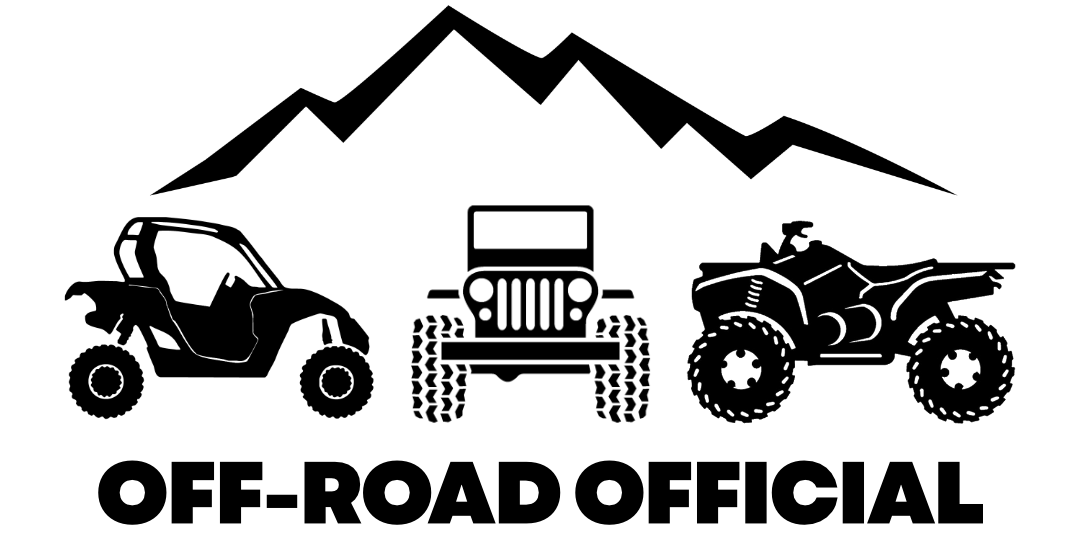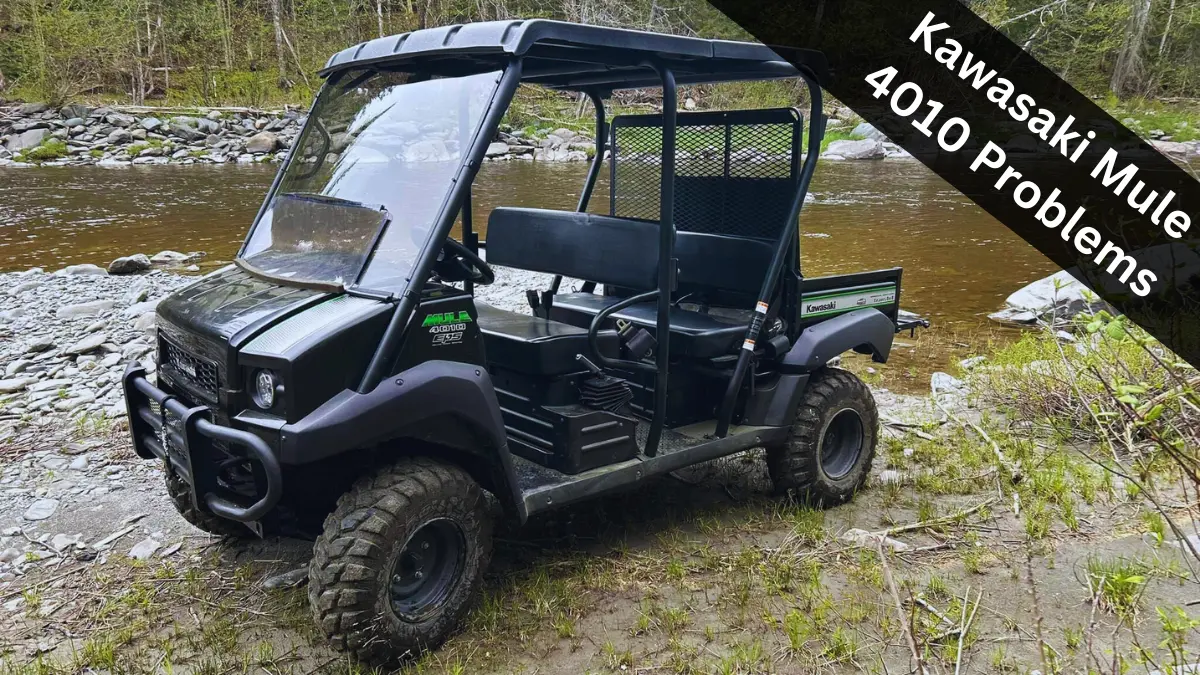The Kawasaki Mule 4010 is Kawasaki’s second smallest UTV, only bigger than the Mule SX.
Despite being smaller and less powerful than the most popular Mule models, like the Kawasaki Mule MX and Kawasaki Mule Pro FXT Ranch Edition, the Mule 4010 is still known for its high-quality build and reliability.
Reading a review of the Mule 4010, you’ll understand why it fits right in line with the full line of Kawasaki Mules being regarded as some of the best utility-focused UTVs on the planet.
But the same review also shows this model is not without its drawbacks.
Let’s review the six most common Kawasaki Mule 4010 problems along with proven fixes for each.
Six Most Common Kawasaki Mule 4010 Problems:
The six most common problems you’ll encounter as a Mule 4010 owner are:
- DFI Light Problem
- Throttle Body Issues
- Chattering From Front Differential
- Starting Problems
- Shifting Problems
- Faulty Fuel Pump
This guide will detail each of them, along with what usually causes them and proven fixes.
Kawasaki Mule 4010 DFI Light Problems
Unless you outfit your Mule 4010 with some of the most popular Kawasaki Mule accessories, these models come pretty basic.
But they do offer some warning/indicator lights on the dash, one of which is the DFI light that has a tendency to light up.
If you see the Digital Fuel Injection (DFI) light flick on, it will most likely be accompanied by your Mule 4010 seemingly running in limp mode or making a lurching motion while in gear.

The DFI light generally comes on as a result of one of the following:
- Failed ignition coil
- Electrical Issue
- The ECU has gone bad
Causes & Fixes
Failed Ignition Coil
A failed ignition coil is one of the more common causes of the DFI light coming on in your Mule 4010.
You should test both your front and rear coils using a spark tester to determine if that’s why your light is on.
If you find that one of them has limited or no spark, that’s most likely your issue and you’ll need to replace the coil.
You can purchase a Mule 4010 ignition coil replacement online and make the change yourself if you prefer.
Electrical Issue
If your DFI light has recently come on after your Mule has gotten wet, either during a ride or from being sprayed down afterwards, you may have an electrical issue.
This may still be your issue even if your Mule hasn’t gotten a bath lately, as sometimes different electrical connections simply vibrate loose from riding around.
Start by checking each of your electrical connections to ensure that none of them have come unplugged or are damaged, as this is one of the leading causes of the DFI light flickering on.
If they all appear fine, you can try spraying an electronic cleaner on every electrical connection in your machine. Once done, try starting your Mule.
If it starts normally but dies out while idling, try restarting it and driving it around (above the idle speed) for 5-10 minutes.
Then try letting it idle. Repeat this process a few times if necessary, as eventually the light may go off and your machine may be back to normal again.
Faulty Electronic Control Unit
If you have a newer model 4010, your Electronic Control Unit (ECU) may have gone out.
The ECU controls your idle speed and can only be adjusted by the dealer. Replacing it is generally covered under warranty.
Kawasaki Mule 4010 Throttle Body Recall
Similar to a common issue found in the Mule Pro MX, constant sputtering and the engine stalling at idle are one of the more common problems with the Mule 4010 as well.
Your 4010 may run like new when giving it some gas, but may struggle when letting off the pedal and being at idle.
These idling issues are most likely the result of a gummed up throttle body.
Common Cause
This tends to happen frequently in the 4010’s because of the configuration of the throttle assembly, where the crankcase vent tube feeds directly back into the air intake for the throttle body.
This faulty configuration is mandated per US EPA regulations that state the crankcase can’t be vented to the atmosphere.
As a result, oil vapors are sucked into the engine and burned creating a gummy substance in the throttle body.
Carbon deposits (a soot-like substance) can build up inside the throttle body as well, intensifying the issue even more.
This issue seemingly only happens with some Mule 4010 models while others never experience it. But the issue was prevalent enough that Kawasaki reportedly issued an “unannounced recall” a few years back.
Fixes
With this unannounced recall, if you were having the issue and contacted a dealer, many of them would put in a new breather kit and throttle body free of charge.
But many owners who ran into this issue and had their throttle body and breather kit replaced simply experienced the same issue again down the road.
There are a few ways to correct this issue aside from replacing the components.
- You can vent the crankcase directly to the atmosphere and then plug the intake port on the throttle body. This will void your warranty and is an “EPA no-no”, but does work.
- You can run the crankcase hose into an oil catch can filter, then plug the intake port on the throttle body. The catch can and filter will cut down on the oil and sludge in the throttle body, but this is not EPA friendly.
- You can run the crankcase vent hose to an oil catch with both an inlet and outlet. The outlet side routes the vapors back into the throttle body, but the catch can removes some of the oil that comes through. This is a more environmentally friendly option.
Kawasaki Mule 4010 Throttle Body Cleaning
Additionally, a thorough cleaning of the throttle body via the steps below should help relieve your Mule 4010’s idling issues temporarily.
- Remove your Mule’s throttle body.
- Spray the throttle body down using this WD-40 Throttle Body Cleaner Spray and then scrub it down good using a toothbrush or scrubbing pad.
- Use your finger to open the electronic-controlled throttle blade and spray the shaft bearing area with the cleaner. Make sure to open it back and forth while spraying and cleaning to ensure you get all the gunk out.
- Then test it out before reinstalling it by hooking up all electrical connections to the throttle body. Turn the key to the idle position and check to see if the throttle blade opens slightly. If it does, you should be good to go and can reinstall the throttle body and fire up your Mule.
Chattering Noise From Front Differential
As the owner of a Mule 4010, you may start hearing a chattering noise coming from the front of your UTV while driving.
This chattering sounds almost like a growl or a metal shield vibrating as you accelerate or decelerate, it’s a pretty common issue in these models.
Fixes
If you experience this and are still under warranty, you should talk to your dealer as a number of owners have been able to get their front differential replaced for free by Kawasaki.
That said, Kawasaki maintains there is nothing wrong with the stock front differentials and this is very rare, when indeed it is not.
Aside from having this chattering fixed by your dealer or local mechanic, there are a couple of things that have worked to limit the chattering.
Using a heavier fluid in your differentials, such as Royal Purple 75w-140 which is within the specified suitable oils for the Mule 4010, will minimize the chattering.
Pair some Lube Gard Limited Slip Supplement with the heavier fluid, and that will quiet the chatter for a couple of months until you’ll need to repeat the process.
Kawasaki Mule 4010 Starting Problems

There are many potential issues that could cause the engine not to start. Some of the more common ones are:
- Defective spark plugs
- Dead battery or loose battery cables
- Transmission not being in neutral
- Bad fuel pump
- Faulty ignition switch
Fixes
Defective Spark Plugs: If you use your Mule for many trips that are shorter in duration, such as a drive to the mailbox and back, you most likely have a spark plug issue if you find that your engine won’t start one day.
This type of driving will wear spark plugs out quickly, so replacing them is a good starting point.
Battery: These short trips can also do a number on your battery, which is what you should inspect next if replacing the spark plug fails to resolve your issue.
Try recharging your battery and checking to ensure all of the battery cables are tightly secured in place before attempting to fire up your Mule again.
Transmission Not In Neutral: If the engine won’t start but just makes a clicking noise, check to ensure that your Mule is in neutral as there is a safety switch which will prevent the engine from starting if not.
However, you can bypass this safety switch on some models by pressing down the brake pedal and then starting it.
Bad Fuel Pump: If you recall hearing a whining sound coming from the fuel tank in the rides before your Mule stopped working, this could mean the fuel pump has gone out and needs to be replaced.
Faulty Ignition Switch: Your ignition switch could also be the issue. You should test its voltage to ensure it does not need to be replaced.
Kawasaki Mule 4010 Shifting Problems
The gear shift sticking when trying to change gears is another common issue experienced with the Kawasaki Mule 4010, and in other Mule models as well.
This likely happens as a result of the type of gearbox installed, referred to as a dog ring gearbox or transmission.
Unfortunately, it seems to be a normal malfunction with these gearboxes but at the same time most likely does not indicate a potential major issue with the transmission or Mule itself.
Fix
There is a fairly simple solution to this issue when you experience it.
If the engine is running and you can’t get the gear to shift, give the engine a little bit of gas, about 100 RPMs, and then shift gears.
This should unstick the shifter and enable you to move it to the desired gear.
If you have powered off while not in neutral, and you experience a stuck gear shift, hold down the brake and start your Mule in its current gear.
You should be able to shift gears from there.
Kawasaki Mule 4010 Fuel Pump Problems
The Kawasaki Mule 4010 and fuel pumps just don’t seem to play nice together, as evidenced by the fuel pumps seemingly consistently going bad with these models.
But this issue is most likely due more in part to the fuel filters than to the fuel pumps themselves.
If your fuel is not clean and has debris in it, it will start to clog the fuel filter.
A clogged fuel filter leads to a lack of fuel in the pump, which results in a lack of lubrication and coolant to the pump’s drive motor, which eventually leads to the drive motor failing and the fuel pump giving out.
Fix
You want to check your fuel filter frequently to make sure it isn’t clogged, which would be indicated by it starting to turn the color of dirt.
If you experience idling issues, a loss of speed/acceleration, or your engine won’t start – you may be dealing with a fuel pump or fuel filter that need replacing.
Conclusion
While some of the common problems experienced with the Mule 4010 can be addressed by taking ongoing proper preventative measures, others are completely out of owners’ control.
For additional support and insight into these issues and others, there are Kawasaki forums where the riding community shares added experience, expertise, and advice in resolving such problems.
These issues considered, the Kawasaki Mule 4010 is still one of the more highly dependable UTV models on the market.
If you’re looking for a smaller sized ultra terrain vehicle that still offers the durability to excel in work-related tasks, the Mule 4010 makes an excellent choice.
For more on Kawasaki Mules, check out the following guides before you go:


